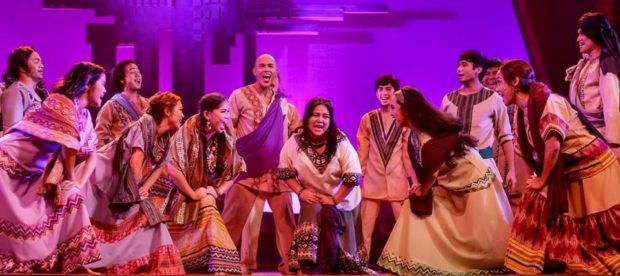
Guadalupe: The Musical,” an original production by Julie Borromeo’s Performing Arts Foundation Inc. (until Oct. 14, Meralco Theater, Pasig City), recounts the miraculous events witnessed by the people of Mexico in 1531.
After an apparition of the Virgin Mary before Juan Diego (Cocoy Laurel), the faith of his town is challenged, caught in an uneasy flux between the people’s newfound religion and the cruelty of the Spanish authorities.
This clash of cultures becomes “Guadalupe’s” biggest strength, serving as a generous source of colorful visuals and intricate music.
Unfortunately, the musical doesn’t build a strong story from its multitude of themes. It has content that gathers bits and pieces of history, but is unable to arrange it into a cohesive whole.
“Guadalupe” draws much of its aesthetic from 16th-century Spanish culture, but also makes sure to preserve some of Mexico’s indigenous Aztec roots in its design. The production is mounted against a backdrop of rocky mountain ranges and the remnants of Aztec architecture, while its smaller details are unmistakably Spanish.
In particular, Celia Diaz-Laurel’s costumes are colorful and, at times, downright opulent, deepening the divide between Mexico’s humble villagers and the ruling elite.
Otherworldly glow
John Batalla’s lighting design helps bring the musical’s spiritual side to the forefront, casting several scenes in an otherworldly glow, or in the flicker of candles, or in spots of light like those inside a cathedral.
However, given this strong visual personality, “Guadalupe” never becomes as immersive as one would hope. There is a constant sense that the material is being performed—the result of its stilted English dialogue, tame direction and unnecessary narrative framing device (which sees a narrator regularly interrupting the action).
As much as the production team tries to keep the musical fresh with the use of multiple points of view, this choice ultimately ends up dividing one’s attention among several tangential stories. The various subplots feel less like a collective ensemble drama and more like bullet points sharing a slide.
All these storylines are vaguely brought together in the miracles brought about by the Virgin Mary. But while these events (the imprinting of the Virgin’s image on Juan Diego’s cloak, the healing of Juan Diego’s uncle, etc.) are, in themselves, awe-inspiring to behold, it’s difficult to see what purpose they serve in the context of the production’s many stories.
And since the musical ends right after the miracles occur, the characters are denied the chance to reflect upon their faith or how this supposed proof of a Christian God comes into conflict with their previous Aztec religion.
Purpose
While the production team may deny it, the story eventually serves an evangelical purpose. This isn’t inherently bad, but it renders the human drama less complex.
That said, the large cast of “Guadalupe” still manages to find space for expressing complex human emotions, even if their characters offer them little to work with.
Laurel performs Juan Diego with a childlike playfulness and wisely avoids adopting the stoic piousness we so commonly associate with saints. Onyl Torres spends most of his performance lying on his deathbed, but he still possesses warmth and tenderness as Juan Diego’s uncle, Juan Bernardino. And Lorenz Martinez (as Archbishop Juan de Zumarraga) and Kuya Manzano (Governor Nuño Beltran de Guzman) are responsible for the musical’s most entertaining, scenery-chewing exchanges.
Cultural overlap
As a whole, the musical makes a stronger case for itself when it concentrates on the cultural overlap between the Aztecs and the Spaniards, over its evangelical goals. Nowhere is this better observed than in Ejay Yatco’s layered, energetic score. “Guadalupe’s” music wears its influences on its sleeve, playing with percussion, indigenous musical sounds and string instruments commonly attributed to the Spanish.
But Yatco also places great focus on voices, filling out many of the songs with multiple vocal parts (“Miracles Are Real” and the first act finale “Fire in the Sky”). There’s thematic unity here, and an impressive sense of scale—qualities that ultimately should have been more present in the actual production.